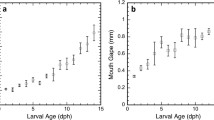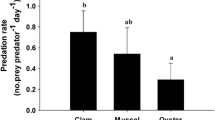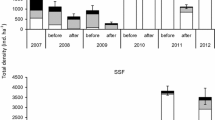Abstract
The effect of feeding behaviour on the prey capture efficiency of young-of-the-year European perch and roach was investigated in laboratory experiments using planktonic crustaceans possessing different escape abilities—Daphnia sp. and Cyclops sp. Two sets of experiments were performed. In the first set, the feeding efficiency and behaviour of 270 fish individuals were determined by stomach content analyses and video record evaluations. In the second set of experiments, analysis of attack-effort, which was evaluated as attack-distance and repeated strikes, was undertaken. Except for situations in which Daphnia was offered at high densities, the feeding efficiency of perch was significantly higher compared to roach in all other combinations of prey types and densities. Roach consumed significantly less prey compared to perch when feeding exclusively on the evasive Cyclops and when it was offered in a 1:1 ratio mixture with Daphnia. The mean swimming speed was similar in both fish species, but behavioural differences were evident during prey search and capture. Perch swam through the aquaria in short and fast movements that were interrupted by many stops. Roach exhibited rather continuous swimming that was punctuated by slowdowns instead of stops. The perch attacks were very intensive and repeated strikes occurred, particularly when feeding on evasive Cyclops. On the other hand, roach revealed strong schooling behaviour restricting the fish during inspection of the experimental aquaria. The distinct differences in feeding efficiency between perch and roach were demonstrated to be closely related to differences in their feeding behaviour. Discontinuous searching for prey, vigorous attacks, occurrence of repeated strikes and the absence of schooling increased perch prey capture efficiency, particularly when foraging on evasive copepods.






Similar content being viewed by others
References
Benndorf, J., 1995. Possibilities and limits for controlling eutrophication by biomanipulation. Internationale Revue der gesamten Hydrobiologie 80: 519–534.
Bergman, E., 1990. Effects of roach Rutilus rutilus on two percids, Perca fluviatilis and Gymnocephalus cernua: importance of species interactions for diet shifts. Oikos 57: 241–249.
Boersma, M., O. F. R. van Tongeren & W. M. Mooij, 1996. Seasonal patterns in the mortality of Daphnia species in a shallow lake. Canadian Journal of Fisheries and Aquatic Sciences 53: 18–28.
Drenner, R. W., R. Strickler & W. J. O’Brien, 1978. Capture probability: the role of zooplankter escape in selective feeding of planktivorous fish. Journal of the Fisheries Research Board of Canada 35: 1370–1373.
Godin, J. G. J., 1986. Antipredator function of shoaling in teleost fishes: a selective review. Naturaliste Canadien 3: 241–250.
Haberlehner, E., 1988. Comparative analysis of feeding, schooling behaviour of the cyprinidae Alburnus alburnus (L., 1758), Rutilus rutilus (L., 1758), Scardinius erythrophthalmus (L., 1758) in a backwater of the Danube near Vienna. International Revue der gesamten Hydrobiologie 73: 537–546.
Hammer, C., 1985. Feeding behaviour of roach (Rutilus rutilus) larvae and the fry of perch (Perca fluviatilis) in Lake Lankau. Archive für Hydrobiologie 103: 61–74.
Hülsmann, S., 2003. Recruitment patterns of Daphnia: a key for understanding midsummer declines? Hydrobiologia 491: 35–46.
Kerfoot, W. C., D. L. Kellog & J. R. Strickler, 1980. Visual observations of live zooplankters: evasion, escape and chemical defenses. In Kerfoot, W. C. (ed.), Evolution and Ecology of Zooplankton Communities. University Press of New England, Hannover, New Hampshire: 10–28.
Krause, J., 1993. The relationship between foraging and shoal position in a mixed shoal of roach (Rutilus rutilus) and chub (Leuciscus cephalus)—a field study. Oecologia 93: 356–359.
Krause, J., D. Bumann & D. Todt, 1992. Relationship between the position preference and nutritional state of individuals in schools of juvenile roach (Rutilus rutilus). Behavioral Ecology and Sociobiology 30: 177–180.
Krause, J., P. Reeves & D. Hoare, 1998. Positioning behaviour in roach shoals: the role of body length and nutritional state. Behaviour 135: 1031–1039.
Lazzaro, X., 1987. A review of planktivorous fishes: their evolution, feeding behaviours, selectivities, and impacts. Hydrobiologia 146: 97–167.
Mark, W., W. Wieser & C. Hohenauer, 1989. Interactions between developmental processes, growth, and food selection in the larvae and juveniles of Rutilus rutilus (L.) (Cyprinidae). Oecologia 78: 330–337.
Matěna, J., 1995. The role of ecotones as feeding grounds for fish fry in a Bohemian water supply reservoir. Hydrobiologia 303: 31–38.
Matěna, J., 1998. Diet spectra and competition between juvenile fish in the pelagic zone of a deep stratified reservoir during the first year of life. International Review of Hydrobiology 83: 577–584.
Macháček, J. & J. Matěna, 1997. Diurnal feeding patterns of age-0 perch (Perca fluviatilis) and roach (Rutilus rutilus) in a steep-sided reservoir. Archive für Hydrobiologie (Special Issues in Advanced Limnology) 49: 59–70.
McComas, S. R. & R. W. Drenner, 1982. Species replacement in a reservoir fish community: silverside feeding mechanisms and competition. Canadian Journal of Fisheries and Aquatic Sciences 39: 815–821.
Mehner, T., M. Plewa, S. Hülsmann, H. Voigt & J. Benndorf, 1997. Age-0 fish predation on daphnids—spatial and temporal variability in the top-down manipulated Bautzen Reservoir, Germany. Archive für Hydrobiologie (Special Issues in Advanced Limnology) 49: 13–25.
Mehner, T., S. Hülsmann, S. Worischka, M. Plewa & J. Benndorf, 1998. Is the midsummer decline of Daphnia really induced by age-0 fish predation? Comparison of fish consumption and Daphnia mortality and life cycle history parameters in a biomanipulated reservoir. Journal of Plankton Research 20: 1797–1811.
Mehner, T. & R. Thiel, 1999. A review of predation impact by 0+ fish on zooplankton in fresh and brackish waters of the northern hemisphere. Environmental Biology of Fishes 56: 169–181.
Northcote, T. G., 1988. Fish in the structure and function of freshwater ecosystems: a “top-down” view. Canadian Journal of Fisheries and Aquatic Sciences 45: 361–379.
Nyberg, D. N., 1971. Prey capture in the largemouth bass. American Midland Naturalist 86: 128–144.
Persson, L., 1987. Effect of habitat and season on competitive interactions between roach (Rutilus rutilus) and perch (Perca fluviatilis). Oecologia 73: 170–177.
Persson, L. & L. A. Greenberg, 1990. Juvenile competitive bottlenecks: the perch (Perca fluviatilis)–roach (Rutilus rutilus) interaction. Ecology 71: 44–56.
Persson, L., S. Diehl, L. Johansson, G. Andersson & S. F. Hamrin, 1991. Shifts in fish communities along the productivity gradient of temperate lakes—patterns and the importance of size-structured interactions. Journal of Fish Biology 38: 281–293.
Peterka, J. & J. Matěna, 2009. Differences in feeding selectivity and efficiency between young-of-the-year European perch (Perca fluviatilis L.) and roach (Rutilus rutilus (L.))—field observations and laboratory experiments on the importance of prey movement apparency vs. evasiveness. Biologia (Bratislava) 64: 786–794.
Post, J. R., 1990. Metabolic allometry of larval and juvenile yellow perch (Perca flavescens): in situ estimates and bioenergetic models. Canadian Journal of Fisheries and Aquatic Sciences 47: 554–560.
Post, J. R. & J. F. Kitchell, 1997. Trophic ontogeny and life history effects in interactions between age-0 fishes and zooplankton. Archive für Hydrobiologie (Special Issues in Advanced Limnology) 49: 1–12.
Romare, P. & E. Bergman, 1999. Juvenile fish expansion following biomanipulation and the effect on the predation pressure on zooplankton. Development in Hydrobiologia 404: 89–97.
Stricker, J. R., 1975. Intra- and interspecific information flow among planktonic copepods: receptors. Verhandlungen des Internationalen Verein Limnologie 19: 2951–2958.
Vašek, M., J. Kubečka, J. Matěna & J. Seďa, 2006. Distribution and diet of 0+ fish within a canyon-shaped European reservoir in late summer. International Review of Hydrobiology 91: 178–194.
Wagner, A., S. Hülsmann, H. Dörner, M. Janssen, U. Kahl, T. Mehner & J. Benndorf, 2004. Initiation of the midsummer decline of Daphnia as related to predation, non-consumptive mortality and recruitment: a balance. Archiv für Hydrobiologie 160: 1–23.
Winfield, I. J. & C. R. Townsend, 1988. Factors affecting prey selection by young bream Abramis brama and roach Rutilus rutilus: insights provided by parallel studies in laboratory and field. Environmental Biology of Fishes 21: 279–292.
Winfield, I. J., G. Peirson, M. Cryer & C. R. Townsend, 1983. The behavioural basis of prey selection by underyearling bream (Abramis brama (L.)) and roach (Rutilus rutilus (L.)). Freshwater Biology 13: 139–149.
Wright, D. I. & W. J. O’Brien, 1984. The development and field test of a tactical model of the planktivorous feeding of white crappie (Pomoxis annularis). Ecological Monographs 54: 65–98.
Wu, L. & A. D. Culver, 1994. Daphnia population dynamics in western Lake Erie: regulation by food limitation and yellow perch predation. Journal of Great Lakes 20: 537–545.
Acknowledgments
Authors are much obliged to two anonymous reviewers for careful reading and helpful comments to the manuscript and H. Hashimi for final correction of the English. This study was supported by the projects IAA60017502, AVOZ60170517 and KJB600960810 of the Grant Agency of the Academy of Sciences of the Czech Republic.
Author information
Authors and Affiliations
Corresponding author
Additional information
Handling editor: M. Power
Rights and permissions
About this article
Cite this article
Peterka, J., Matěna, J. Feeding behaviour determining differential capture success of evasive prey in underyearling European perch (Perca fluviatilis L.) and roach (Rutilus rutilus (L.)). Hydrobiologia 661, 113–121 (2011). https://doi.org/10.1007/s10750-010-0507-1
Received:
Revised:
Accepted:
Published:
Issue Date:
DOI: https://doi.org/10.1007/s10750-010-0507-1




